The flight from Cancun to Havana was an experience. The Cubana airlines plane was a very old 1970’s Yakovlev YAK-42 Russian plane with too many rows of seats squeezed into
it so we didn’t have any leg room or a window in our row at the very back of the plane. All the seats fell forward if you leaned on them, the arm rests fell backwards on to other peoples legs, there were no fasten seat belt
signs, all signs were in a cyrillic language and when the jet took off it rattled, shook and filled with vapor from the freezing cold air that was furiously pumping in around our feet. Thank goodness it was only an hour long flight we had to endure and we were happy when the stewards offered us our first taste of Havana
Club with a Cuba Libre. The plane does sound terrible but it was the smoothest take off and landing I think I have ever had on a plane.
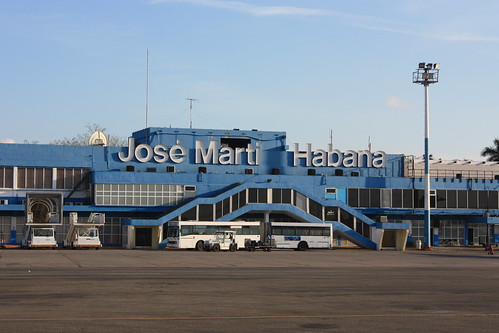
Havana
Cuba’s not a cheap place to stay and there are no hostels available for backpackers so we chose to stay with Daniel and Fina who run a ‘casa particular’, a home where
people apply for a license to offer rooms for rent to tourists at a much lower cost then staying in a state run hotel or resort. It was a beautiful apartment on the third floor of a building in Havana Centro, where one of
the original members of the Buena Vista Social Club still lives, and our room had a little balcony overlooking the street and rooftops of Havana.
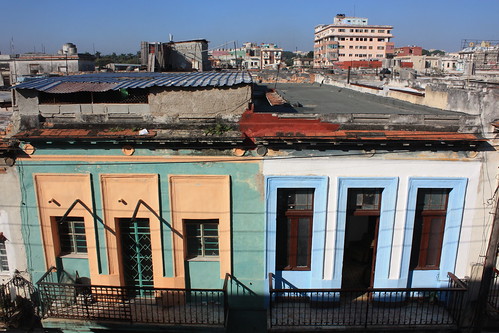
It was a great experience to live in a local neighbourhood and see how Havaneros really live and the casa was in easy walking distance to Old Havana, the Malecon
and the Vedado suburb, which was a welcome relief to us as it turns out Havana is a very safe city to walk around even late at night, which was so unusual to us after Central America where you can’t wander to some places
in daylight without an armed guard with you. So with that in mind we set off on foot to explore Havana’s many highlights.
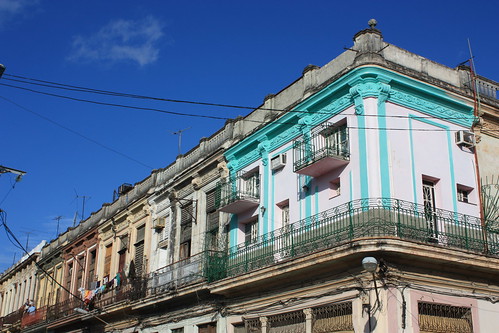
The Plaza de la Revolucion is a huge open area where rallies and historical speeches have been held and where Castro has stood to address the masses on many occasions. With
the giant Jose Marti monument (the founder of the original revolution movement) towering above, it felt very important and we took the elevator to the top for a birds eye view of Havana and a look down onto the offices of
Castro.
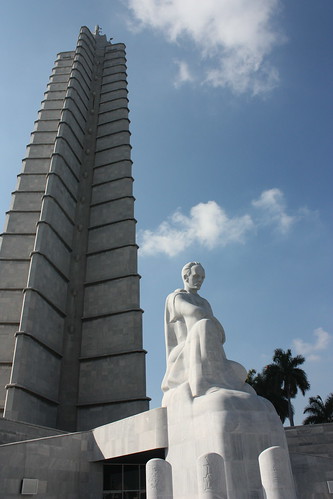
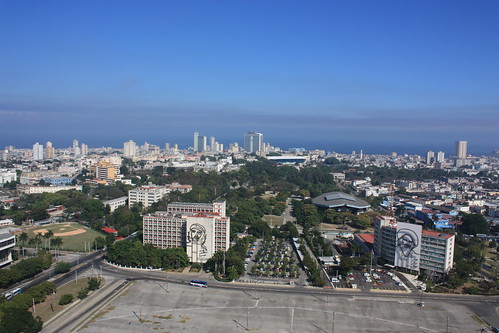
On the other side of the plaza is the Ministry of the Interior building with a picture of Che looking over the area.
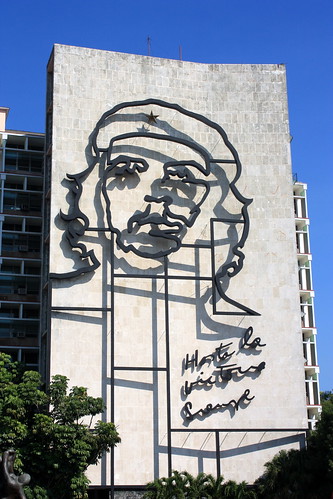
Some wouldn’t call our next stop a highlight but when we headed to the Cristobal Colon cemetery to take a tour of the graves it was like walking around a history book. The
cemetery is special because it’s the largest in the country and 1 in 5 Havaneros are buried there, that’s over 1 million people so far and it’s the only place in the whole of Cuba where there is private property (the
state owns everything else). We took a tour with a funny lady who liked to whisper jokes at Castro’s expense but who was also a huge fan of Simon Cowell, go figure. She told us the history of the important people who are
buried in the grounds including past presidents, the inventor of the mojito, famous musicians and the grave where Castro made his first ever political speech, kick-starting his career, along with miracle graves and fascinating
stories from Havana’s past.
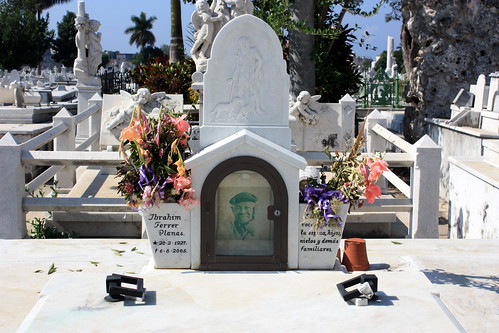
When we were walking around Havana we always came across murals of revolutionary slogans, propaganda and pictures of Che and Castro, reminding us of the socialist state the
people live in.
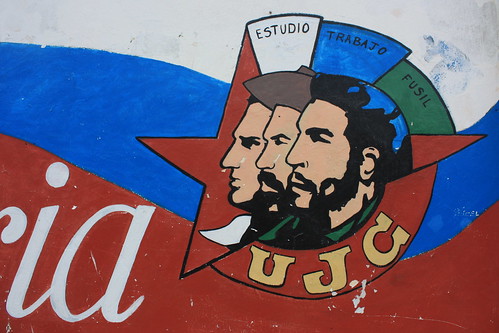
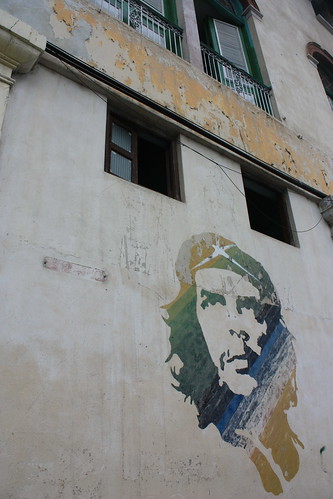
All the walking would make us hungry but we were disappointed when we had our first taste of bad Cuban cuisine that we had been warned about. We ordered a fried rice that
was being cooked outside a state-run cafe and it looked quite tasty, but it turned out to be cold, bland and I think it involved some spam...oh right we had just eaten spam fried rice, yuck!
The state run restaurants and museums all have women attendants wearing what looks like a 1960s air stewardess outfit with beehive hairdos, it’s very easy to feel in a time warp
in Cuba, especially when every one in three cars in Cuba were built in the 1950’s giving a glimpse of what life was like back in those days.

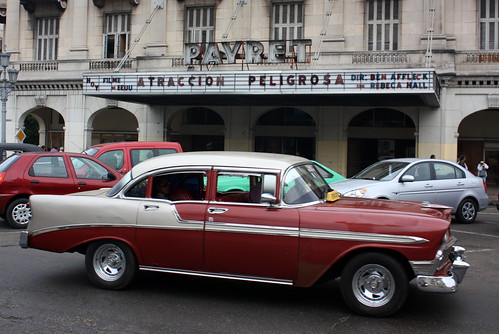
The old cars would always honk at us asking if we wanted a taxi even though it is illegal for them to pick up foreigners, we should only take state run official taxis that
cost more, but the illegal ones still try their luck because they know they can make a few CUCs out of tourists. Sometimes we couldn’t pass up the opportunity to jump in an oldsmobile and go hurtling along in a huge lump
of metal whilst we sunk down into the seat. The buses are also very old but are slowly being replaced by new Chinese buses and the city is famous for it’s little balls of sunshine, the coco taxis beep beeping down the road.
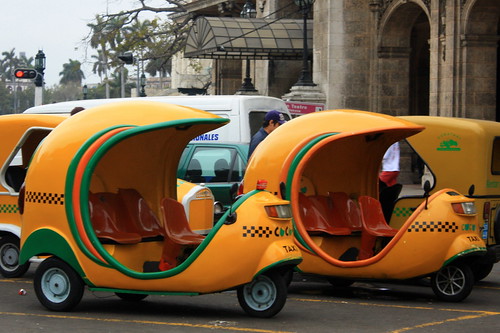
Strolling down La Rampa main avenue in Vedado was a highlight for spotting art deco buildings and we overtook queues and queues of people lining up to buy anything and everything.
Only so many people can do something at once, like enter a store or bank, so everyone has to queue and wait their turn and there is definitely no pushing in allowed as you always hear calls for ‘el ultimo’ (the last in
the queue).
We thought we would try out the institutional ice cream parlor that every Cuban had recommended as a highlight to us, Coppelia’s Ice Cream store, the most famous and delicious
ice cream in Cuba (though the standards are not very high). We wanted to join the peso queue with everyone else and wait our turn to be told what flavour of ice cream we had to have as there’s only one or two flavours on
offer each day, but instead the security guard wouldn’t let us through and showed us to the foreigners section where we had to pay in CUC because we were tourists although we could sit and order what we wanted from an array
of flavours.
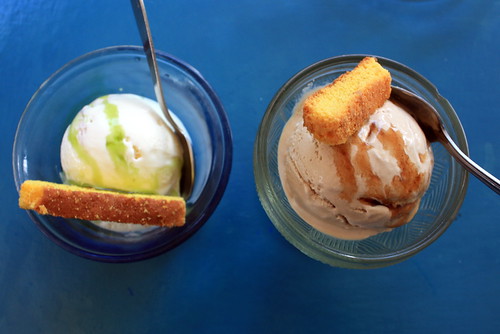
We were fast learning that there is a two tier system in Cuba, them and us! If you work for the state you get to pay cheap prices but the quality and choice is considerably
less. If you don’t work for the state you get a huge price increase but the quality is much better and there are more options. You feel like you are being put on a pedestal but really you are just a commodity for the country
to make more money, which it desperately needs.
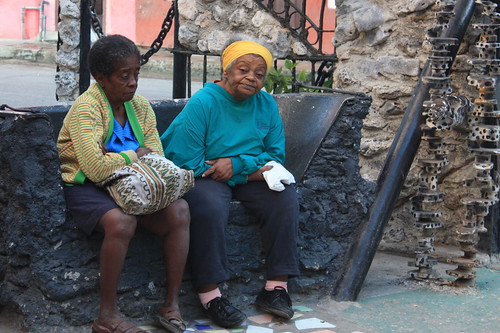
There are two currencies in Cuba and most Cubans use pesos or CUP and are paid with this, but there are also CUC convertible pesos that foreigners use for hotels, dinner,
museums etc, which were brought in to replace the use of US dollars. If you go to a place where they sell food and drink in pesos it’s very hard to pay using that currency because they always give tourists a menu with prices
in CUC even though they have the peso menu on the wall and you can see what something is really worth. The interesting thing about Cuban currency is that it’s the only country we’ve visited that has a 3 denomination note
in the system.
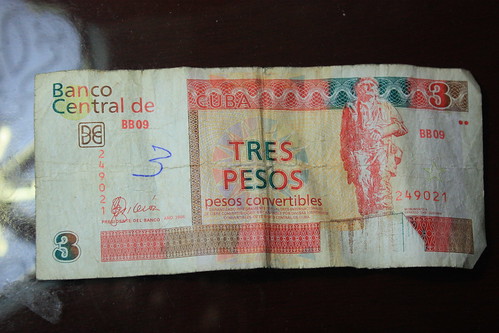
Havana has hundreds of museums and galleries but the must visit museum in the city is the Museo de la Revolucion based in the old presidential palace that was stormed in 1953
by students and still shows bullet holes from the event. It was really interesting and full of artifacts and photos showing how Castro won the revolution and came to power and the centrepiece is the shrine they have built
that holds the original boat, Granma, which brought Castro, Che and the other revolutionaries to Cuba from Mexico.
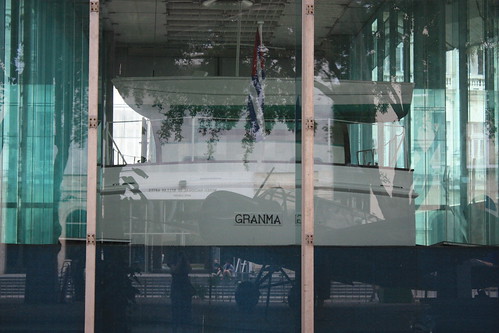
The best view of Havana can be seen from the Castillo that looks across the harbour over all of the city and the malecon. No wonder Che used part of the building as his headquarters
in Havana, definitely a prime location.
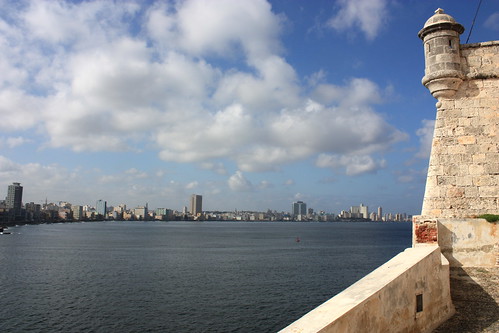
The main tourist draw of the capital is Havana Vieja (Old Havana), which is full of cobblestone plazas lined with churches, fancy colonial buildings and posh hotels, people hanging their laundry out to dry on the balconies overhead, book bazaars selling history books...
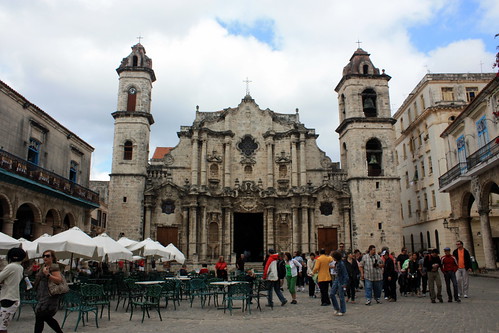

...men playing
music
and women dressed up in fancy costumes smoking fat cigars, all trying to make
a CUC or two for a photo opportunity.

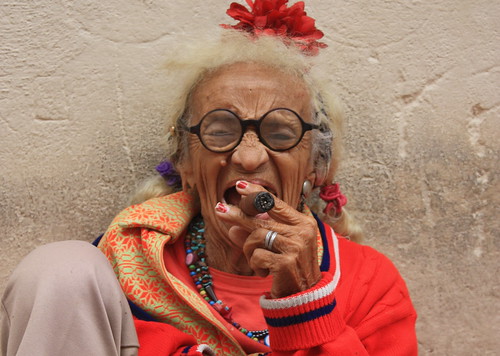
But we were a little underwhelmed by this part of town. It was the area where you got hassled the most to buy cigars, to eat in a restaurant, take a horse carriage ride, mainly
because Cubans are desperate to make more money then the state pays them and tourists are the easiest way to make some hard cash. We much preferred the other suburbs of Havana as you could wander around with much less hassle,
people didn’t turn their heads at two tourists walking around they just let you fit in and it didn’t seem so fake. We really liked the colourful Callejon de Hamel in the Vedado district that has been turned into an art
and music project that hosts street concerts every weekend.
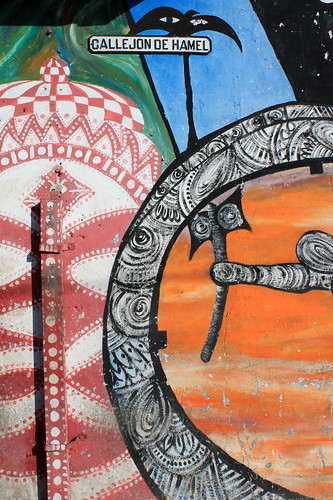
My personal highlight of Havana was the Malecon, especially when the winds picked up and sent waves crashing down onto the road and pavement as the sea pounded the Malecon
wall and occasionally soaking a tourist who was getting too close to take a photo. They even have to close the road when the conditions are too bad.
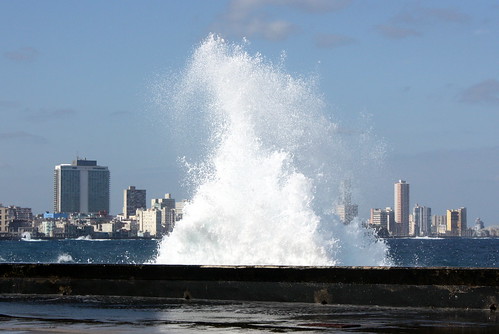
To see a different part of Havana we took a long, long walk to the baseball stadium to watch Cuba’s equivalent of the Yankees, the Industriales vs Isla de la Juvented. Raul,
the cook at our casa, had recommended we go to see them as they’re the best team in Cuba. We weren’t allowed to buy a ticket at the regular ticket office so we were escorted around the corner to buy tickets from the foreigners
window for a 750% mark up on the ticket price. Ok so cubans only pay 1 peso to enter ($0.04) and we paid $3, which is kind of fair and still very cheap for us. Let’s face it, if it cost Cubans any more to go to a game they
wouldn’t be able to afford it, the game would have no crowd and possibly no supporters so there would be no point in having a national sport to boost moral. Final score? We don’t actually know the final score because we
only watched five innings, which took over three hours. It was a slow game but with lots of scoring and we were lucky to see a very rare occurrence in our first inning where an Industriales player hit an inside the park grand
slam, something you could go to thousands of games and never see happen. It was a great atmosphere and there were some very heated discussions going on around us, which you would expect to break out into a riot if it was a football
game, but it’s just the flair and passion Cubans have for their teams and they all end up hugging when they eventually agree to disagree. It was a bit out of the way but it turned into the highlight of our visit to the capital
and was worth the effort.
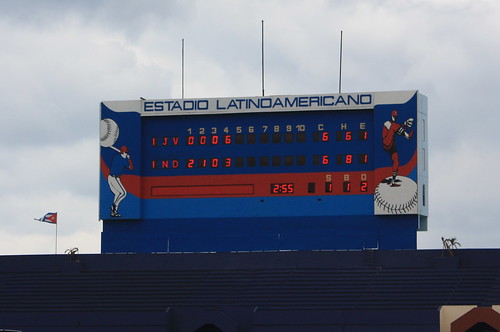
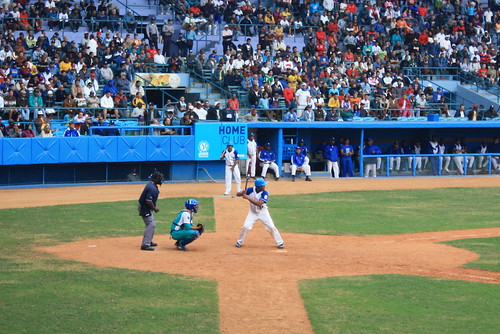
To relax in the evenings after all the walking we did, we would partake in one of Cuba’s finest past times...Mojitos and Jazz, need I say more!
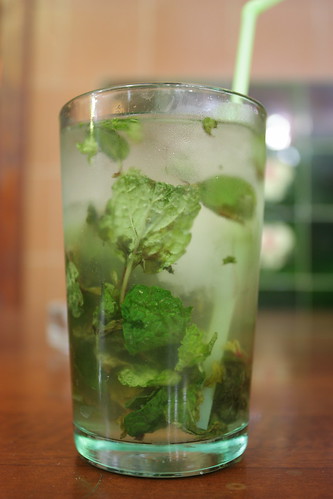
We were fascinated by Havana and Ryan has claimed it as his favourite captial city in Latin America. It attacks all your senses at the same time. Just wandering down a street
you can’t help but look up and down at all the architecture styles, whether they are still intact or looking like they will collapse if the wind blows too hard. It’s difficult not to peer into peoples windows and doorways
and marvel at the antique furniture that looks in pristine condition, the size of the rooms and the number of people all living together. You can’t help but take clandestine peeks at peoples outfits and hairdos, some from
another era, some way too tight and some that are old but so well cared for they could last a lifetime. You can’t help but stare at the queues of people lining up at tiny windows waiting to buy a pizza or bread or waiting
to pay a telephone bill, they make you want to join the queue just to feel part of the system. You feel your head turning as a 1950’s American beast of a car rides by full of people trying to get some of their way home for
the evening. Your ears fill with the sound of jazz music as it floats down from an apartment window above and your nose fills with the sweet smell of cigar smoke you can’t help but inhale on every street corner. With everyone
relentlessly fighting for your CUC there is quite a bit not to like about Havana, but there is also so much about the city that you can’t help but fall in love with it. We’re glad we got to see it as it is today and experience
its charms along with it faults, as it may not remain this way for very much longer.
And then we headed to...
Jo y Ryan
Photos: http://www.flickr.com/photos/dojo77/